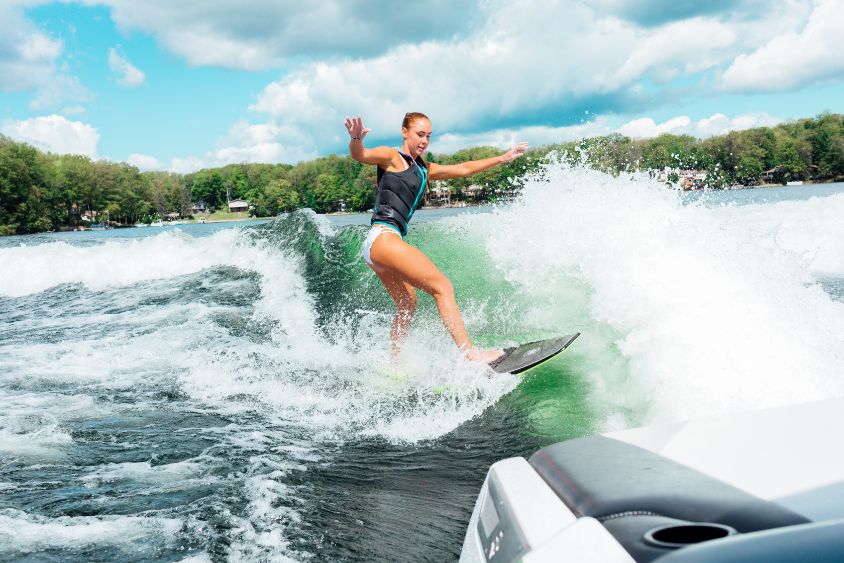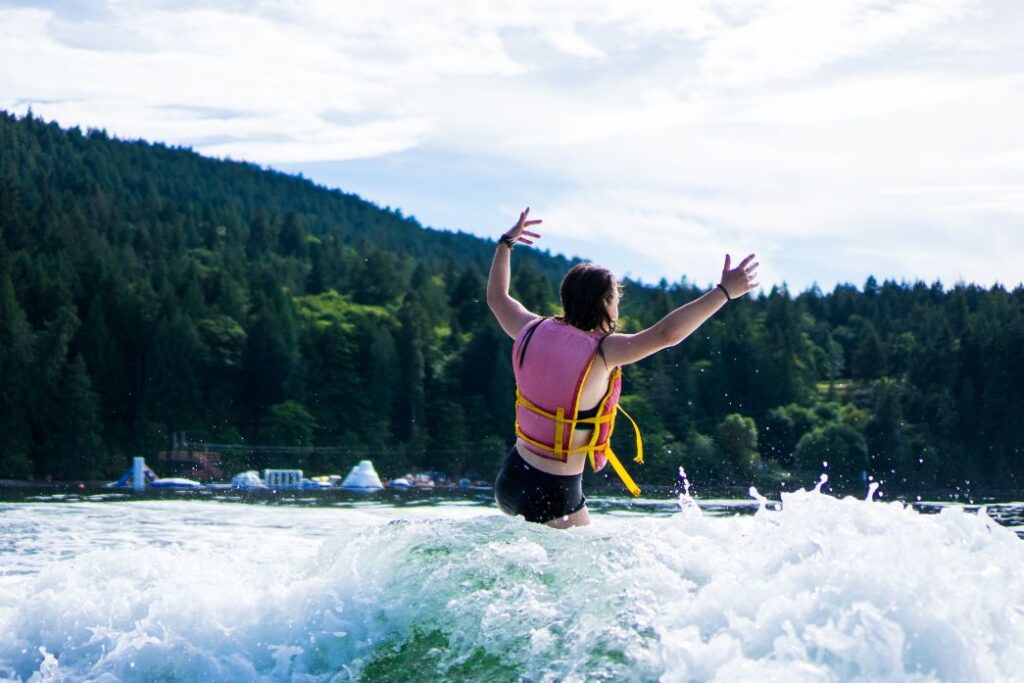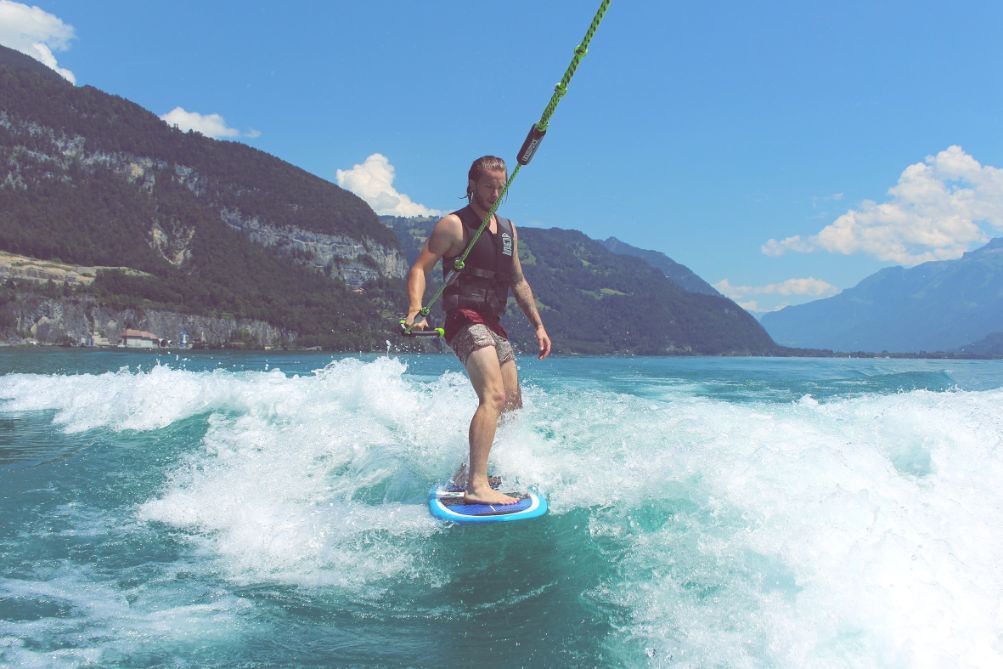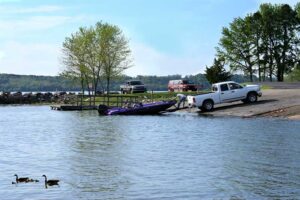Wakesurfing is your one-way ticket to summertime enjoyment, and if you dress in a wetsuit, you can also enjoy it throughout the rest of the year. For some people, picking up wakeboarding as a new hobby can be very intimidating. Wakeboarding might seem challenging at first glance, but once you get the hang of it, it’s actually quite simple.
You can quickly become an expert at wakeboarding if you have the proper gear and put in the necessary practice. Here is a thorough introduction to wakeboarding for beginners.
Can You Wakesurf Behind Any Boat?
Although some boats can really go above and beyond in this regard, you might think that any old boat can be good for making waves. V-drive boats are one illustration. These boats have the engine close to the back of the vessel.
The propeller is located under the hull for added safety, and they can be weighted to help create large waves. The Malibu Wakesetter 23 LSV is an illustration of a good V-drive boat. Wakeboarding can also be done well on inboard direct drive boats.
You can check out more information we have on Wakesurf Behind A Pontoon Boat.
What Should I Wear Wakesurfing?
It’s crucial to be organized before heading out onto the water. What to wear is the first step. Although wearing a swimsuit is obvious, there are a few other things to consider. Even though you might want to flaunt your summer body, choosing clothing with more coverage will keep you safe.
Also, keep in mind that you’ll be wearing a life jacket, so pick a swimsuit that is comfortable and supportive to wear underneath it. A wetsuit or rashguard might also be appropriate for beginning wakesurfers.
You’ll probably spend more time in the water as a beginner, and depending on where you are, the water can get chilly. Additionally, having more coverage will better shield you from potential falls.
A life jacket is probably the most crucial piece of gear you’ll wear while wakeboarding. Life jackets not only keep you afloat but also provide some safety in the event of a fall. Make sure to select a life jacket that is rated for your size and weight and has Coast Guard approval.
What Gear Should You Take?

The Board
If you’re just starting in wakesurfing, seek out the “beginner boards.” Wakesurfing boards come in different varieties, and learning to ride some of them can be challenging for beginners. Although the physical differences are slight, they are noticeable in how they behave when a rider is present.
The Rope
Irrespective of whether you think it or not, choosing the right rope is crucial. For example, a wakesurfing rope differs from a wakeboarding rope, which differs from a ski rope. Wakesurfing ropes are shorter, thicker, and have a thickly padded handle. Some even have knots to help new riders pull themselves into the wave’s “sweet spot,” which we’ll explain later.
Life Jacket Or Pfd
Personal flotation equipment is also something you’ll need. Instead of the blocky foam pieces you may remember, modern PFDs resemble down vests more than anything else. For finding downed riders, bright colors are beneficial.
How Do I Pick A Wakeboard For A Beginner?
You’ll learn to wakesurf more quickly and have more fun if you pick the right beginner wakesurf board. Beginner wakeboarders prioritize stability and predictability over speed and pop. We advise choosing wakesurf boards in the surf shape that have a larger surface area and a stable three fin setup.
The most reliable and forgiving platform to learn the fundamentals will be provided by doing this. The construction and buoyancy of beginning wakeboarders is another distinguishing feature. The materials used to make beginner boards are frequently less buoyant, allowing them to float lower in the water for slower speeds and greater stability.
What Should You Prepare For Wakesurfing?
Adjusting The Boat For Wakesurfing
Different areas of the boat’s ballast are filled with concrete or lead weights. The side of the boat that the rider will be riding on is where the weights are placed. The majority of the weight should be next to the engine in V-drive boats.
On the side you want to wakeboard, a small amount should be under or on the seat. Weight is put behind the engine and on the side of direct drive boats. You should also think about how many passengers you have and where they are sitting on the boat. The wave size will increase with the depth of the wake boat in the water.
Try out a boat with more technologically advanced adjusting options as your wakesurfing skills improve. Because technology has advanced so much, it is now possible to modify your own waves and settings to suit the preferences of a given rider. Pretty cool stuff.
Wake Propeller
Some wakesurf boats weren’t really designed to spend the entire day on their sides. Changing your propellers is one modification that could help with that. A propeller with a large diameter will increase the amount of power transferred from the engine to the water.

Your propeller ought to have a lower pitch as well. A propeller’s pitch is the distance it travels during a complete rotation. You perform better at wakeboarding when the pitch is lower because more rotations per minute are occurring.
Wakesurf Rope
After setting up your boat, you still need a good wakesurf rope. First, let’s put safety first. The wakesurfing rope with the smallest handle is the safest option. It is safer because it lessens the chance that the rider’s arms or legs will become trapped inside during a fall.
The last thing you want is to drop to the ground and get dragged under a boat that is traveling at a speed of 10 to 15 miles per hour. Decide on a small handle for the wakesurf rope. Being able to hold on with just one arm is made easier by a smaller handle, which also improves performance.
Your desired length of rope should be looped around the wakesurf tower. The rope should be between 10 and 20 feet long. You will be in the perfect location on the wave to really practice your surfing thanks to this. It’s best to avoid switching out the ropes you use for water skiing or wakeboarding.
The best wakesurfing-specific ropes are thicker, shorter, and more knotted. To get on the right part of the wave and move around more easily, you can use however much rope you like.
Beginner’s Guide To Wakesurfing
You’ll be prepared to enter the ocean once you’ve obtained your wakesurfing gear and finished making adjustments.
You should test various components frequently to ensure a smooth ride on the waves, including the rope length, boat weight adjustment, and wake propeller. Here are the steps to learning how to wakesurf:
Wakesurfing Step By Step
- Don a life jacket, grab a board and a rope, and dive into the water. Learn how to stand up now. Take the board and turn it so that it is parallel to the boat first. Then, you step onto the board with your heels closest to the rail that is closest to you. Lay down in the water and relax.
- Give the boat the thumbs up to begin moving. On the board, you’ll slowly raise yourself up, then turn it in either a normal or amusing position. On the left or right side, try to avoid the wake.
- You should slowly drift into the wake and then slowly back out of it. After a few tries, you’ll find your rhythm and it will become simpler.
- You’ll be able to move closer to the boat by placing more weight on your front foot. You can lean back by putting weight on your back foot. When you drop back, keep in mind to hold onto the rope because the wake will knock you off the board.
- Put weight on both your front and back feet to locate the sweet spot. Release the rope, toss it onto the boat, and cruise down the wake wave.
- By practicing snaps on top of the wake, grab the rope and get comfortable. As you approach the top of the wake, begin to edge out and shift your weight to the backfoot. As you descend the top of the wake, kick back your back foot and push your weight onto it. Go over the wake with the board’s nose.
What Is A Pump Trick?
You can generate speed and bounce using this intermediate trick. When you master this skill, you’ll be able to perform tricks like 180s and 360s.
- If there is no rope, you should put weight on your back foot to rise to the top of the wake.
- After that, you begin to descend the wake by placing weight on your front foot.
- Try it; it’s said to help you gain speed.
How To Do A 360?
- Return to your sweet spot, which is between the wake’s center and its edge.
- Install as many good pumps as you can to generate speed.
- By raising your front foot off the board, you can raise the wakesurf board’s nose. The next step is to simultaneously push your back foot out and dig your backhand into the wake.
- This will cause it to become loose, allowing you to move your body from left to right.
- You’ll notice that as you become more comfortable with your 360s, your weight will start to shift from the front to the back.
How To Get Air?
- Get two to three solid pumps in to gain enough speed after drifting back into your sweet spot.
- Make a big bottom turn after your final pump, then come down on your front foot weight.
- At the peak of the wake, turn around. Keep your front foot really light as you ascend, and almost the entire board should leave the wake.
- As you descend the wake, you can then begin to put more weight on your front foot. Your back foot will be able to rise as a result, and it will level out above the lip.
- You should make sure that both your front and back feet touch the ground equally first. On your front foot and back foot, equally distribute the weight.
Practice, Practice, Practice
The best thing about wakeboarding is that it’s enjoyable to practice and that crashes are much less painful than in other water sports. Go riding with people who are more skilled than you.
In wakesurfing, you ride so close to the boat that you can hear the crew members giving you instructions while you’re on the water and immediately put what you learn to use. Furthermore, there is absolutely no hurry. You can ride that wave for as long as you like.



